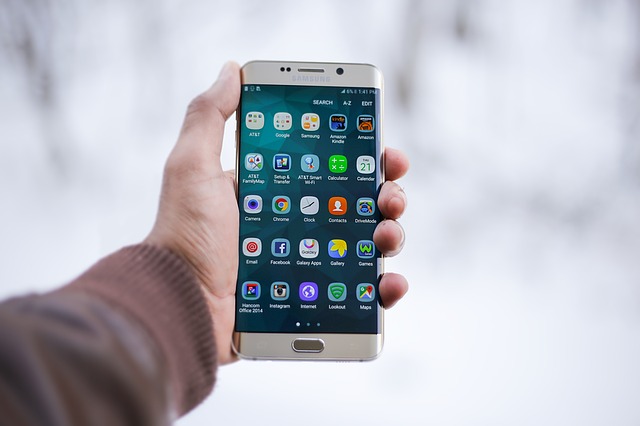Steps to Understanding The Mobile App Development Lifecycle
- Home
- MOBILE APP
- Steps to Understanding The Mobile App Development Lifecycle
 May 2, 2020
May 2, 2020 Throughout all the app projects we’ve worked on, one consistent trend I noticed is that mobile app development is like a black box especially if you don’t know how to code.
If you’re considering building a mobile app for your small to medium-sized business, you need to know exactly what it takes to execute. .
Mobile use statistics tell a very compelling story for businesses still on the fence:
- Mobile apps account for over half of all time spent consuming digital media.
- Smartphone users spend about 90 percent of their mobile time on apps.
- 85 percent of consumers prefer native mobile apps over a mobile website.
- Mobile apps account for 42 percent of all mobile sales for Fortune 500 companies.
- Revenue from mobile apps is expected to reach nearly $60 billion in the U.S. in 2020.
- The average consumer has about 30 apps installed on his device and spends about 35 hours a month using them.
Of course, even with all the evidence in favor of building an app, the decision to move forward isn’t one to be taken lightly. With about 1.5 million apps each in Google Play and Apple’s App Store, it’s important to understand the mobile app development process and how your app will fit with both your market niche and your marketing goals. With that said, here’s a look at the app development lifecycle and the objectives and challenges along the way.
Discovery, Market Research, And Mobile App Development Tech-stack.
You may already have a few good mobile app ideas for your business, and that’s a good place to start. But before you move into the design and development phase, your first step should be a deep dive into research—into your own business and target audience, as well as that of your competitors. You’ll need answers to the following questions:
- What do you want your mobile app to accomplish? Where does it fit in your mobile marketing plans?
- Who is your target audience?
- How do you want your customers to use your app?
- What platform (or platforms) will you use?
- Which mobile app development language and framework should you use?
- What are your competitors doing? Do they have apps? If so, what features do they offer?
- What is your overall app development budget?
- What is your timeline for development? When will you launch your app?
- How will you market and promote your app?
If you haven’t done so already, put together your app development team with members from relevant departments (executive leadership, marketing and/or sales, product development, IT, etc.) and hash out the information you gathered during the research and discovery phases. Informed feedback in these early stages will pave the way for a smoother development process.
Establishing Mobile App Goals and Objectives
This is a crucial step in the planning phase of your mobile app. Once you’ve determined an app will advance important objectives in your mobile marketing scheme, you need to map out how your app will get you there.
- What problem (or problems) will your app solve for your customers?
- What features will it include?
- What is your app’s core appeal?
In many cases, determining your app’s features and benefits is a balancing act between your overall app development budget and your in-house capabilities. However, when it comes to prioritizing functionality, research shows that app design should emphasize customer engagement over exclusive services.
Wireframes and Storyboards

At this stage, you should have a pretty good idea about what your app will look like and what features you want to include. You should also have developed a scope of work—which pieces of the process will be performed in-house and which will be contracted out. Now it’s time to start sketching out your app and creating a storyboard.
There are many online tools for wireframing your app; your goal at this point is to develop a clear picture of how your ideas and proposed features will fuse together into a functional app. You should also create a storyboard, or roadmap, to demonstrate the connections between each screen and how users will navigate through the app. Keep these pointers in mind as you sketch:
- Look for opportunities to incorporate your brand.
- Focus on the user experience.
- Consider the differences in the way people use a mobile app versus a mobile website.
Defining the Backend of Your Mobile App
Your wireframes and storyboard will serve as a guide for the backend structures you’ll need to support your app—think APIs, data diagrams, servers, data integration, and push notification services. In many cases, SMEs find choosing a mobile backend as a service (BaaS) platform makes sense, since they solve common challenges such as scalability and lack of in-house talent.
One caveat: You may need to modify your wireframes and/or storyboard if you encounter technical limitations in the backend development process, so stay flexible at this early stage.
Finalize Your Wireframe and Test Your Prototype

At this point, you should nail down any changes in your wireframe identified during the backend planning process. Once your team has agreed upon the wireframe and storyboard, it’s time to build an interactive prototype.
Prototyping is an essential step in the app development process, because it gives you an opportunity to really evaluate design concepts, gather feedback, and identify dead links and flaws in the flow and usability of your mobile app. There are several good prototyping tools available online to simplify the process.
It’s a good idea to bring in people who are not part of your mobile app team to test and evaluate your prototype. Observe them as they interact with the app and ask for honest feedback on the app’s overall functionality and ease of use. Adapt the UI/UX to correct for any shortcomings identified during this stage.
Your goal is to finalize your app design concept and create a high fidelity prototype that will guide you through the actual app development process.
Developing the App
Actually developing the app involves a number of steps and processes. If you aren’t using an app development platform or mobile BaaS provider, your developer will have to set up the actual storage solutions, databases, APIs, and servers for the backend of your app.
Don’t forget to set up developer accounts for the app stores you plan to use to distribute your app, if you don’t already have them; this step can take several days to complete and is easy to overlook. It’s also a good idea to read through the app store guidelines so your app isn’t rejected during the review process.
You’re now ready to move into the programming and coding phase. If you’ve hired outside talent to develop your app, be sure to get a signed non-disclosure agreement and establish a timeline for deliverables. Keep in mind the “hire slow, fire fast” maxim and give yourself a quick out if you aren’t pleased with your programmer’s capabilities after the project starts.
At this stage, your designer will create the app “skins,” or actual screens used in your mobile app. These high-resolution renderings of your wireframes represent the interface your users will eventually use to interact with your app, so make sure your designs incorporate all the ideas and feedback collected during the earlier testing phase. After all, you are creating an app you want your customers and target audience to actually enjoy using, so UI/UX details matter.
Test and Test Again
This is an exciting time in the app development lifecycle—you finally have a complete app concept with exciting graphics and perfectly placed text. Now you need to rigorously test your app in a variety of real-world scenarios to sniff out and correct any technical flaws.
Go back to your original design and planning documents and go through every feature; don’t assume something works in the final concept just because it worked during the development phase.
Again, it’s a good idea to observe other users as they test the app—they may have questions and insights that aren’t obvious to you since you’ve been involved in app development since the earliest days. You may even want to use one of the online mobile UX testing tools that give you real-time feedback and analytics; several work on a freemium model that is cost effective for SMEs. Be sure to test for cross platform compatibility of images, graphics, and user experience.
When you’re confident your app is working correctly in all scenarios and you’re happy with the appearance and usability of the interface, it’s time to make the final preparations to launch your mobile app.
Preparing for Launch

The steps you take to prepare for your app launch may have the greatest effect on its ultimate success, and getting your marketing department involved early in the process is one of the most important. Marketing will help you with keyword research, which is essential for SEO and app store optimization (ASO), both of which are key for discoverability.
Your market and keyword research will guide your choices for app titles and descriptions as you prepare to submit your mobile app to the various marketplaces for distribution. You’ll also want to get high-quality screenshots of your app and maybe even a promotional video and/or demo at this point.
You’ll also need a website—or at least a landing page—to support and promote your app. This is important for branding and awareness, and also for search and discoverability; Google’s App Indexing API uses content within your app and your app’s web page in its search results algorithm. Key components of your app’s landing page or website should include:
- your app’s name and icon
- badges and names of the stores where your app can be downloaded
- screenshots and your promotional video
- a mailing list/subscription form (pre-launch) and download links (post launch)
- contact and support information
- links to your social media accounts
- a press kit
- testimonials and user reviews (post launch)
Be sure to promote your app on your business website and on your social media accounts; if you have a company blog, publish updates throughout the development process to create interest and anticipation. It’s also a good idea to launch an email campaign. Depending on your market niche and the type of app you are building, you may also want to enlist the help of experts and social influencers to help promote your app.
As you walk through your app promotion checklist, don’t forget to include app analytics to help you optimize your app and increase its appeal to your target audience. Google Analytics is a good place to start.
Now is also a good time to consider alternative app marketplaces, aside from Apple’s App Store and Google Play, to distribute your app. Another option to consider during the pre-launch phase is submitting your app to PreApps, an app marketplace that connects developers with early adopters, for some pre-release feedback.
Official Release
Your official release date should represent the climax of your app marketing efforts up to this point. It’s time to create some buzz with write-ups and articles by influential bloggers and journalists—and to make an announcement to everyone who showed interest in your app prior to launch. Promote your release with an email blast and mentions (with links) on all your social media profiles. The idea is to generate downloads and ratings, and build some momentum.
Don’t rest on your laurels once your app is released; you want to keep your new users engaged. This is a great time to use push notifications to announce a special offer or promotion so users will open your app. Consider offering incentives such as a one-time discount or free product or service for customers who download your app. Remember that marketing your app is an ongoing process, and your release-date efforts are just the beginning.
Finally, have a clear channel for feedback and be responsive to the comments and concerns of your users; a timely update or fix can work wonders for retaining your customers. Pay attention to your analytics and track those KPIs that define success for your marketing objectives.
Once you understand the key processes and steps in the mobile app development lifecycle, you’ll be better prepared to develop an app with the function and features you need—on a budget and timeline you can comfortably manage.


